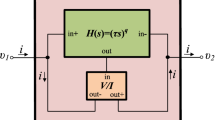Abstract
Once designing analogue fractional-order function blocks, the capacitive and/or inductive fractional-order elements (FOEs), also referred to as constant phase elements, being defined with their fractional order \(\alpha\) (\(0< \alpha < 1\)) are required. Although currently capacitive FOEs are being discussed in the literature, still these passive elements are not readily available in discrete form and mainly do not offer the whole span of \(\alpha\). Therefore, to overcome such an obstacle, we primary propose the transformation of FOEs and their fractional order \(\alpha\) to obtain the complement order \(\beta\), whereas \(\beta =1{-}\alpha\). Following the theory and mathematical description, also other transformation cases on fractional-order element are discussed and analysed in this paper. Using simple impedance converter employing single current conveyor and transconductance amplifier, the theoretical presumptions are verified both by simulations and experimental measurements.











Similar content being viewed by others
References
Freeborn, T. J. (2013). A survey of fractional-order circuits models for biology and biomedicine. IEEE Journal on Emerging and Selected Topics in Circuits and Systems, 3, 416–424.
Ortigueira, M. D. (2008). An introduction to the fractional continuous time linear systems: The 21st century systems. IEEE Circuits and Systems Magazine, 8, 16–26.
Elwakil, A. (2010). Fractional-order circuits and systems: an emerging interdisciplinary research area. IEEE Circuits and Systems Magazine, 10, 40–50.
Agambayev, A., Patole, S. P., Farhat, M., Elwakil, A., Bagci, H., & Salama, K. N. (2017). Ferroelectric fractional-order capacitors. ChemElectroChem, 4, 2807–2813.
Shahinpoor, M. (2016). Ionic polymer metal composites (IPMCs). Smart multi-functional materials and artificial muscles (Vol. 2, pp. P001–P434). Cambridge: The Royal Society of Chemistry.
John, D. A., Banerjee, S., Bohannan, G. W., & Biswas, K. (2017). Solid-state fractional capacitor using MWCNT-epoxy nanocomposite. Applied Physics Letters, 110, 163504.
Gil’mutdinov, A Kh, Ushakov, P. A., & El-Khazali, R. (2017). Fractal elements and their applications, XVIII-252. Cham: Springer.
Tsirimokou, G. (2017). A systematic procedure for deriving RC networks of fractional-order elements emulators using MATLAB. AEU-International Journal of Electronics and Communications, 78, 7–14.
Koton, J., Herencsar, N., Kubanek, D., & Psychalinos, C. (2017). Fractional-order elements of complement order. In Proceedings of the international conference on electrical and electronics engineering–ELECO 2017, Bursa Turkey (pp. 1212–1215)
Berndt, D. F., & Dutta, S. C. (1969). Roy, Inductor simulator using a single unity gain amplifier. IEEE Journal of Solid-State Circuits, 4, 161–162.
Antoniou, A. (1969). Realisation of gyrators using operational amplifiers, and their use in RC-active-network synthesis. Proceedings of the Institution of Electrical Engineers, 116, 1838–1850.
Kacar, F., & Kuntman, H. (2011). CFOA-based lossless and lossy inductance simulators. Radioengineering, 20, 627–631.
Koton, J., Herencsar, N., & Venclovsky, M. (2015). History, progress and new results in synthetic passive element design employing CFTAs. International Journal of Advances in Telecommunications, Electrotechnics, Signals and Systems, 4, 15–26.
Temes, G. C., & Lapatra, J. W. (1977). Introduction to circuit synthesis and design, 400. London: McGraw-Hill.
Chung, W.-S., Kim, H.-J., & Cho, K.-M. (2004). Current-controllable FDNRs using linear transcapacitance amplifiers. International Journal of Electronics, 91, 421–430.
Senani, R., Bhaskar, D. R., & Singh, A. K. (2015). Current conveyors: Variants, applications and hardware implementations, 560. Cham: Springer.
Datasheet AD844: 60 MHz, 2000 V/\(\mu\)s Monolitic Op Amp with Quad Low Noise, Analog Devices, Rev. G (2017)
Senani, R. (1998). Realization of a class of analog signal processing/signal generation circuits: Novel configurations using current feedback op-amps. Frequenz, 52, 196–206.
Fabre, A. (1992). Gyrator implementation from commercially available transimpedance operational amplifiers. Electronics Letters, 28, 263–264.
Acknowledgements
This work was supported by Czech Science Foundation under Grant No. 16-06175S and the National Sustainability Program under Grant LO1401. For the research, infrastructure of the SIX Center was used. This article is based upon work from COST Action CA15225, a network supported by COST (European Cooperation in Science and Technology).
Author information
Authors and Affiliations
Corresponding author
Rights and permissions
About this article
Cite this article
Koton, J., Kubanek, D., Herencsar, N. et al. Designing constant phase elements of complement order. Analog Integr Circ Sig Process 97, 107–114 (2018). https://doi.org/10.1007/s10470-018-1257-7
Received:
Revised:
Accepted:
Published:
Issue Date:
DOI: https://doi.org/10.1007/s10470-018-1257-7




